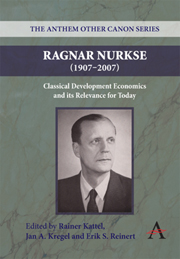Book contents
- Frontmatter
- Contents
- Preface
- Title in the series
- 1 The Relevance of Ragnar Nurkse and Classical Development Economics
- 2 Life and Time of Ragnar Nurkse
- 3 Nurkse and the Role of Finance in Development Economics
- 4 Early Development Theory from Sun Yat-sen to Ragnar Nurkse
- 5 The Roots of Unequal Exchange: Mihail Manoilescu and the Debate of the 1930s
- 6 Nurkse and the Early Latin American Structuralists: A Reflection on Development Theory, Industrialization and their Relevance Today
- 7 Lewis, the Long Wave and Industrialization in the Periphery
- 8 Ragnar Nurkse and the Law & Economics of Development
- 9 Ragnar Nurkse's Development Theory: Influences and Perceptions
- 10 Nurkse meets Schumpeter: Is Microfinance a ‘Silver Bullet’ to Economic Development?
- 11 Stockpiling of International Reserves and Development: a Misguided Link
- 12 International Currency Experience and the Bretton Woods System: Ragnar Nurkse as Architect
- 13 Some Reflections on Nurkse's Patterns of Trade and Development
- 14 India and Development Economics: External Influences and Internal Responses
- Notes
9 - Ragnar Nurkse's Development Theory: Influences and Perceptions
Published online by Cambridge University Press: 05 March 2012
- Frontmatter
- Contents
- Preface
- Title in the series
- 1 The Relevance of Ragnar Nurkse and Classical Development Economics
- 2 Life and Time of Ragnar Nurkse
- 3 Nurkse and the Role of Finance in Development Economics
- 4 Early Development Theory from Sun Yat-sen to Ragnar Nurkse
- 5 The Roots of Unequal Exchange: Mihail Manoilescu and the Debate of the 1930s
- 6 Nurkse and the Early Latin American Structuralists: A Reflection on Development Theory, Industrialization and their Relevance Today
- 7 Lewis, the Long Wave and Industrialization in the Periphery
- 8 Ragnar Nurkse and the Law & Economics of Development
- 9 Ragnar Nurkse's Development Theory: Influences and Perceptions
- 10 Nurkse meets Schumpeter: Is Microfinance a ‘Silver Bullet’ to Economic Development?
- 11 Stockpiling of International Reserves and Development: a Misguided Link
- 12 International Currency Experience and the Bretton Woods System: Ragnar Nurkse as Architect
- 13 Some Reflections on Nurkse's Patterns of Trade and Development
- 14 India and Development Economics: External Influences and Internal Responses
- Notes
Summary
Introduction
The present discussion on a ‘rebirth’ of systematic development economics (Herrera 2006) renders it appropriate to look more closely at its theoretical foundations before it became absorbed in an ad-hoc reasoning vis-à-vis the increasingly complex reality of (many) falling-behind and (few) catching-up processes, eventually falling into near oblivion for three decades (Krugman 1994). Undoubtedly, Ragnar Nurkse, the great Estonian-American economist, was undoubtedly one of the most rigorous theoreticians and therefore his contribution to the sub-discipline of development economics deserves special attention when discussing the relevance of classical development economics for today.
Ragnar Nurkse's contribution to economics was in three areas, the later being an extension of the previous ones (for details on the bio-bibliographical background see Basu 1987, Kukk 2004, Bass 2007): The first period of his work (in the 1930s) was dedicated to research on international capital movements. In the middle period (in the 1930s/1940s), he additionally covered issues of international trade and finance. Finally (from the mid-1940s to his death in 1959), he considered the international commodity and factor movements and their financial framework as merely one aspect of a broader issue in the world economy, to which he then turned his attention: the overcoming of structural underdevelopment. His three most eminent publications are hallmarks of these three phases: Internationale Kapitalbewegungen (in German, 1935), International Currency Experience (1944) and Problems of Capital Formation in Underdeveloped Countries (1953).
- Type
- Chapter
- Information
- Ragnar Nurkse (1907–2007)Classical Development Economics and its Relevance for Today, pp. 183 - 202Publisher: Anthem PressPrint publication year: 2009
- 1
- Cited by

